The Low-Dimensional Three-Dimensional Tin Halide Perovskite: Film Characterization and Device Performance
Abstract
1. Introduction
2. Halide Perovskite Solar Cells
2.1. Halide Perovskite Materials
2.2. Halide Perovskite Solar Cells
2.3. Tin-Based Perovskites
3. Three-Dimensional Tin Perovskite Solar Cells
3.1. MASnI3
3.2. FASnI3
3.3. CsSnI3
4. Low-Dimensional Three-Dimensional Tin-Based Perovskite Solar Cells
4.1. 2D Sn Perovskite Solar Cells
4.2. 2D/3D Sn Perovskite Solar Cells
5. Conclusions
Author Contributions
Funding
Conflicts of Interest
References
- Nakamura, M.; Yamaguchi, K.; Kimoto, Y.; Yasaki, Y.; Kato, T.; Sugimoto, H. Cd-Free Cu (In, Ga) (Se, S) 2 Thin-Film Solar Cell with Record Efficiency of 23.35%. IEEE J. Photovolt. 2019, 9, 1863–1867. [Google Scholar] [CrossRef]
- Green, M.A.; Dunlop, E.D.; Levi, D.H.; Hohl-Ebinger, J.; Yoshita, M.; Ho-Baillie, A.W.Y. Solar cell efficiency tables (version 54). Prog. Photovolt. 2019, 27, 565–575. [Google Scholar] [CrossRef]
- NREL. Available online: https://www.nrel.gov/pv/assets/pdfs/best-research-cell-efficiencies.20190923.pdf (accessed on 23 September 2019).
- Benick, J.; Richter, A.; Müller, R.; Hauser, H.; Feldmann, F.; Krenckel, P.; Riepe, S.; Schindler, F.; Schubert, M.C.; Hermle, M. High-efficiency n-type HP mc silicon solar cells. IEEE J. Photovolt. 2017, 7, 1171–1175. [Google Scholar] [CrossRef]
- Toshniwal, A.; Kheraj, V. Development of organic-inorganic tin halide perovskites: A review. J. Sol. Energy 2017, 149, 54–59. [Google Scholar] [CrossRef]
- Konstantakou, M.; Stergiopoulos, T. A critical review on tin halide perovskite solar cells. J. Mater. Chem. A 2017, 5, 11518–11549. [Google Scholar] [CrossRef]
- Wang, J.; Dong, J.; Lu, F.; Sun, C.; Zhang, Q.; Wang, N. Two-dimensional lead-free halide perovskite materials and devices. J. Mater. Chem. A 2019, 7, 23563–23576. [Google Scholar] [CrossRef]
- Chakhmouradian, A.R.; Woodward, P.M. Celebrating 175 years of perovskite research: A tribute to Roger H. Mitchell. Phys. Chem. Miner. 2014, 41, 387–391. [Google Scholar] [CrossRef]
- Goldschmidt, V.M. Die gesetze der krystallochemie. Naturwissenschaften 1926, 14, 477–485. [Google Scholar] [CrossRef]
- Travis, W.; Glover, E.; Bronstein, H.; Scanlon, D.; Palgrave, R. On the application of the tolerance factor to inorganic and hybrid halide perovskites: A revised system. Chem. Sci. 2016, 7, 4548–4556. [Google Scholar] [CrossRef]
- Li, C.; Lu, X.; Ding, W.; Feng, L.; Gao, Y.; Guo, Z. Formability of ABX3 (X = F, Cl, Br, I) Halide Perovskites. Acta Crystallogr. Sect. B Struct. Sci. 2008, 64, 702–707. [Google Scholar] [CrossRef]
- Kojima, A.; Teshima, K.; Shirai, Y.; Miyasaka, T. Organometal halide perovskites as visible-light sensitizers for photovoltaic cells. J. Am. Chem. Soc. 2009, 131, 6050–6051. [Google Scholar] [CrossRef] [PubMed]
- Im, J.-H.; Lee, C.-R.; Lee, J.-W.; Park, S.-W.; Park, N.-G. 6.5% efficient perovskite quantum-dot-sensitized solar cell. Nanoscale 2011, 3, 4088–4093. [Google Scholar] [CrossRef] [PubMed]
- Lee, M.M.; Teuscher, J.; Miyasaka, T.; Murakami, T.N.; Snaith, H.J. Efficient hybrid solar cells based on meso-superstructured organometal halide perovskites. Science 2012, 338, 643–647. [Google Scholar] [CrossRef] [PubMed]
- Kim, H.-S.; Lee, C.-R.; Im, J.-H.; Lee, K.-B.; Moehl, T.; Marchioro, A.; Moon, S.-J.; Humphry-Baker, R.; Yum, J.-H.; Moser, J.E. Lead iodide perovskite sensitized all-solid-state submicron thin film mesoscopic solar cell with efficiency exceeding 9%. Sci. Rep. 2012, 2, 591. [Google Scholar] [CrossRef] [PubMed]
- Heo, J.H.; Im, S.H.; Noh, J.H.; Mandal, T.N.; Lim, C.-S.; Chang, J.A.; Lee, Y.H.; Kim, H.-j.; Sarkar, A.; Nazeeruddin, M.K. Efficient inorganic-organic hybrid heterojunction solar cells containing perovskite compound and polymeric hole conductors. Nat. Photonics 2013, 7, 486–491. [Google Scholar] [CrossRef]
- Burschka, J.; Pellet, N.; Moon, S.-J.; Humphry-Baker, R.; Gao, P.; Nazeeruddin, M.K.; Grätzel, M. Sequential deposition as a route to high-performance perovskite-sensitized solar cells. Nature 2013, 499, 316. [Google Scholar] [CrossRef] [PubMed]
- Liu, M.; Johnston, M.B.; Snaith, H.J. Efficient planar heterojunction perovskite solar cells by vapour deposition. Nature 2013, 501, 395. [Google Scholar] [CrossRef]
- Yang, W.S.; Noh, J.H.; Jeon, N.J.; Kim, Y.C.; Ryu, S.; Seo, J.; Seok, S.I. High-performance photovoltaic perovskite layers fabricated through intramolecular exchange. Science 2015, 348, 1234–1237. [Google Scholar] [CrossRef]
- Saliba, M.; Matsui, T.; Domanski, K.; Seo, J.-Y.; Ummadisingu, A.; Zakeeruddin, S.M.; Correa-Baena, J.-P.; Tress, W.R.; Abate, A.; Hagfeldt, A. Incorporation of rubidium cations into perovskite solar cells improves photovoltaic performance. Science 2016, 354, 206–209. [Google Scholar] [CrossRef]
- Jeon, N.J.; Na, H.; Jung, E.H.; Yang, T.-Y.; Lee, Y.G.; Kim, G.; Shin, H.-W.; Seok, S.I.; Lee, J.; Seo, J. A fluorene-terminated hole-transporting material for highly efficient and stable perovskite solar cells. Nat. Energy 2018, 3, 682. [Google Scholar] [CrossRef]
- Rühle, S. Tabulated values of the Shockley—Queisser limit for single junction solar cells. J. Sol. Energy 2016, 130, 139–147. [Google Scholar] [CrossRef]
- Shockley, W.; Queisser, H.J. Detailed balance limit of efficiency of p-n junction solar cells. J. Appl. Phys. 1961, 32, 510–519. [Google Scholar] [CrossRef]
- An, Q.; Ma, X.; Gao, J.; Zhang, F. Solvent additive-free ternary polymer solar cells with 16.27% efficiency. Sci. Bull. 2019, 64, 504. [Google Scholar] [CrossRef]
- Public Health Service. Toxicological Profile for Lead (Update); Agency for Toxic Substances and Disease Registry (ATSDR): Atlanta, Ga, USA, 2007.
- Saad, A.A.; El-Sikaily, A.; Kassem, H. Essential, non-essential metals and human health. Blue Biotechnol. 2014, 3, 447. [Google Scholar]
- Landrigan, P.J.; Schechter, C.B.; Lipton, J.M.; Fahs, M.C.; Schwartz, J. Environmental pollutants and disease in American children: Estimates of morbidity, mortality, and costs for lead poisoning, asthma, cancer, and developmental disabilities. Environ. Health Perspect. 2002, 110, 721–728. [Google Scholar] [CrossRef] [PubMed]
- Chatterjee, S.; Pal, A.J. Influence of metal substitution on hybrid halide perovskites: Towards lead-free perovskite solar cells. J. Mater. Chem. A 2018, 6, 3793–3823. [Google Scholar] [CrossRef]
- Hoefler, S.F.; Trimmel, G.; Rath, T. Progress on lead-free metal halide perovskites for photovoltaic applications: A review. Mon. Chem. 2017, 148, 795–826. [Google Scholar] [CrossRef]
- Saparov, B.; Mitzi, D.B. Organic–inorganic perovskites: Structural versatility for functional materials design. Chem. Rev. 2016, 116, 4558–4596. [Google Scholar] [CrossRef]
- Jena, A.K.; Kulkarni, A.; Miyasaka, T. Halide perovskite photovoltaics: Background, status, and future prospects. Chem. Rev. 2019, 119, 3036–3103. [Google Scholar] [CrossRef]
- Filip, M.R.; Giustino, F. Computational screening of homovalent lead substitution in organic–inorganic halide perovskites. J. Phys. Chem. C 2015, 120, 166–173. [Google Scholar] [CrossRef]
- Kieslich, G.; Sun, S.; Cheetham, A.K. An extended tolerance factor approach for organic–inorganic perovskites. Chem. Sci. 2015, 6, 3430–3433. [Google Scholar] [CrossRef] [PubMed]
- Wang, K.; Yang, D.; Wu, C.; Sanghadasa, M.; Priya, S. Recent Progress in Fundamental Understanding of Halide Perovskite Semiconductors. Prog. Mater. Sci. 2019. [Google Scholar] [CrossRef]
- Miao, J.; Zhang, F. Recent Progress on Highly Sensitive Perovskite Photodetectors. J. Mater. Chem. C 2019, 7, 1741–1791. [Google Scholar] [CrossRef]
- Saliba, M.; Correa-Baena, J.P.; Grätzel, M.; Hagfeldt, A.; Abate, A. Perovskite solar cells: From the atomic level to film quality and device performance. Angew. Chem. Int. Ed. 2018, 57, 2554–2569. [Google Scholar] [CrossRef] [PubMed]
- Chen, Q.; De Marco, N.; Yang, Y.M.; Song, T.-B.; Chen, C.-C.; Zhao, H.; Hong, Z.; Zhou, H.; Yang, Y. Under the spotlight: The organic–inorganic hybrid halide perovskite for optoelectronic applications. Nano Today 2015, 10, 355–396. [Google Scholar] [CrossRef]
- Meng, W.; Wang, X.; Xiao, Z.; Wang, J.; Mitzi, D.B.; Yan, Y. Parity-forbidden transitions and their impact on the optical absorption properties of lead-free metal halide perovskites and double perovskites. J. Phys. Chem. Lett. 2017, 8, 2999–3007. [Google Scholar] [CrossRef]
- Drago, R.S. Thermodynamic evaluation of the inert pair effect. J. Phys. Chem. 1958, 62, 353–357. [Google Scholar] [CrossRef]
- Chen, Z.; Wang, J.J.; Ren, Y.; Yu, C.; Shum, K. Schottky solar cells based on CsSnI3 thin-films. Appl. Phys. Lett. 2012, 101. [Google Scholar] [CrossRef]
- Chung, I.; Song, J.-H.; Im, J.; Androulakis, J.; Malliakas, C.D.; Li, H.; Freeman, A.J.; Kenney, J.T.; Kanatzidis, M.G. CsSnI3: Semiconductor or metal? High electrical conductivity and strong near-infrared photoluminescence from a single material. High hole mobility and phase-transitions. J. Am. Chem. Soc. 2012, 134, 8579–8587. [Google Scholar] [CrossRef]
- Miao, J.; Zhang, F. Recent Progress on Photomultiplication Type Organic Photodetectors. Laser Photonics Rev. 2019, 13. [Google Scholar] [CrossRef]
- Hao, F.; Stoumpos, C.C.; Chang, R.P.; Kanatzidis, M.G. Anomalous band gap behavior in mixed Sn and Pb perovskites enables broadening of absorption spectrum in solar cells. J. Am. Chem. Soc. 2014, 136, 8094–8099. [Google Scholar] [CrossRef] [PubMed]
- Yang, Z.; Rajagopal, A.; Chueh, C.C.; Jo, S.B.; Liu, B.; Zhao, T.; Jen, A.K.Y. Stable Low-Bandgap Pb–Sn Binary Perovskites for Tandem Solar Cells. Adv. Mater. 2016, 28, 8990–8997. [Google Scholar] [CrossRef] [PubMed]
- Manser, J.S.; Christians, J.A.; Kamat, P.V. Intriguing optoelectronic properties of metal halide perovskites. Chem. Rev. 2016, 116, 12956–13008. [Google Scholar] [CrossRef] [PubMed]
- Yang, D.; Lv, J.; Zhao, X.; Xu, Q.; Fu, Y.; Zhan, Y.; Zunger, A.; Zhang, L. Functionality-Directed Screening of Pb-Free Hybrid Organic–Inorganic Perovskites with Desired Intrinsic Photovoltaic Functionalities. Chem. Mater. 2017, 29, 524–538. [Google Scholar] [CrossRef]
- Stoumpos, C.C.; Malliakas, C.D.; Kanatzidis, M.G. Semiconducting tin and lead iodide perovskites with organic cations: Phase transitions, high mobilities, and near-infrared photoluminescent properties. Inorg. Chem. 2013, 52, 9019–9038. [Google Scholar] [CrossRef]
- Hao, F.; Stoumpos, C.C.; Cao, D.H.; Chang, R.P.; Kanatzidis, M.G. Lead-free solid-state organic-inorganic halide perovskite solar cells. Nat. Photonics 2014, 8, 489–494. [Google Scholar] [CrossRef]
- Yao, Z.; Yang, Z.; Liu, Y.; Zhao, W.; Zhang, X.; Liu, B.; Wu, H.; Liu, S.F. Local temperature reduction induced crystallization of MASnI 3 and achieving a direct wafer production. RSC Adv. 2017, 7, 38155–38159. [Google Scholar] [CrossRef]
- Noel, N.K.; Stranks, S.D.; Abate, A.; Wehrenfennig, C.; Guarnera, S.; Haghighirad, A.-A.; Sadhanala, A.; Eperon, G.E.; Pathak, S.K.; Johnston, M.B. Lead-free organic–inorganic tin halide perovskites for photovoltaic applications. Energy Environ. Sci. 2014, 7, 3061–3068. [Google Scholar] [CrossRef]
- Liu, Y.; Yang, Z.; Cui, D.; Ren, X.; Sun, J.; Liu, X.; Zhang, J.; Wei, Q.; Fan, H.; Yu, F. Two-inch-sized perovskite CH3NH3PbX3 (X= Cl, Br, I) crystals: Growth and characterization. Adv. Mater. 2015, 27, 5176–5183. [Google Scholar] [CrossRef]
- Chen, Z.; Turedi, B.; Alsalloum, A.Y.; Yang, C.; Zheng, X.; Gereige, I.; AlSaggaf, A.; Mohammed, O.F.; Bakr, O.M. Single-Crystal MAPbI3 Perovskite Solar Cells Exceeding 21% Power Conversion Efficiency. ACS Energy Lett. 2019, 4, 1258–1259. [Google Scholar] [CrossRef]
- Umari, P.; Mosconi, E.; De Angelis, F. Relativistic GW calculations on CH3NH3PbI3 and CH3NH3SnI3 Perovskites for Solar Cell Applications. Sci. Rep. 2014, 4, 4467. [Google Scholar] [CrossRef] [PubMed]
- Tsarev, S.; Boldyreva, A.G.; Luchkin, S.Y.; Elshobaki, M.; Afanasov, M.I.; Stevenson, K.J.; Troshin, P.A. Hydrazinium-assisted stabilisation of methylammonium tin iodide for lead-free perovskite solar cells. J. Mater. Chem. A 2018, 6, 21389–21395. [Google Scholar] [CrossRef]
- Dang, Y.; Zhou, Y.; Liu, X.; Ju, D.; Xia, S.; Xia, H.; Tao, X. Formation of Hybrid Perovskite Tin Iodide Single Crystals by Top-Seeded Solution Growth. Angew. Chem. Int. Ed. 2016, 55, 3447–3450. [Google Scholar] [CrossRef] [PubMed]
- Ma, L.; Hao, F.; Stoumpos, C.C.; Phelan, B.T.; Wasielewski, M.R.; Kanatzidis, M.G. Carrier diffusion lengths of over 500 nm in lead-free perovskite CH3NH3SnI3 films. J. Am. Chem. Soc. 2016, 138, 14750–14755. [Google Scholar] [CrossRef] [PubMed]
- Fujihara, T.; Terakawa, S.; Matsushima, T.; Qin, C.; Yahiro, M.; Adachi, C. Fabrication of high coverage MASnI3 perovskite films for stable, planar heterojunction solar cells. J. Mater. Chem. C 2017, 5, 1121–1127. [Google Scholar] [CrossRef]
- Mandadapu, U.; Vedanayakam, S.V.; Thyagarajan, K.; Reddy, M.R.; Babu, B. Design and Simulation of High Efficiency Tin Halide Perovskite Solar Cell. Int. J. Renew. Energy Res. 2017, 7, 1603–1612. [Google Scholar]
- Song, T.-B.; Yokoyama, T.; Stoumpos, C.C.; Logsdon, J.; Cao, D.H.; Wasielewski, M.R.; Aramaki, S.; Kanatzidis, M.G. Importance of Reducing Vapor Atmosphere in the Fabrication of Tin-Based Perovskite Solar Cells. J. Am. Chem. Soc. 2017, 139, 836–842. [Google Scholar] [CrossRef]
- Hao, F.; Stoumpos, C.C.; Guo, P.; Zhou, N.; Marks, T.J.; Chang, R.P.; Kanatzidis, M.G. Solvent-mediated crystallization of CH3NH3SnI3 films for heterojunction depleted perovskite solar cells. J. Am. Chem. Soc. 2015, 137, 11445–11452. [Google Scholar] [CrossRef]
- Yokoyama, T.; Cao, D.H.; Stoumpos, C.C.; Song, T.-B.; Sato, Y.; Aramaki, S.; Kanatzidis, M.G. Overcoming short-circuit in lead-free CH3NH3SnI3 perovskite solar cells via kinetically controlled gas–solid reaction film fabrication process. J. Phys. Chem. Lett. 2016, 7, 776–782. [Google Scholar] [CrossRef]
- Yu, Y.; Zhao, D.; Grice, C.R.; Meng, W.; Wang, C.; Liao, W.; Cimaroli, A.J.; Zhang, H.; Zhu, K.; Yan, Y. Thermally evaporated methylammonium tin triiodide thin films for lead-free perovskite solar cell fabrication. RSC Adv. 2016, 6, 90248–90254. [Google Scholar] [CrossRef]
- Zhao, Z.; Gu, F.; Li, Y.; Sun, W.; Ye, S.; Rao, H.; Liu, Z.; Bian, Z.; Huang, C. Mixed-Organic-Cation Tin Iodide for Lead-Free Perovskite Solar Cells with an Efficiency of 8.12%. Adv. Sci. 2017, 4. [Google Scholar] [CrossRef] [PubMed]
- Ke, W.; Stoumpos, C.C.; Spanopoulos, I.; Mao, L.; Chen, M.; Wasielewski, M.R.; Kanatzidis, M.G. Efficient lead-free solar cells based on hollow en MASnI3 perovskites. J. Am. Chem. Soc. 2017, 139, 14800–14806. [Google Scholar] [CrossRef] [PubMed]
- Zhao, B.; Abdi-Jalebi, M.; Tabachnyk, M.; Glass, H.; Kamboj, V.S.; Nie, W.; Pearson, A.J.; Puttisong, Y.; Gödel, K.C.; Beere, H.E. High Open-Circuit Voltages in Tin-Rich Low-Bandgap Perovskite-Based Planar Heterojunction Photovoltaics. Adv. Mater. 2017, 29. [Google Scholar] [CrossRef]
- Handa, T.; Yamada, T.; Kubota, H.; Ise, S.; Miyamoto, Y.; Kanemitsu, Y. Photocarrier recombination and injection dynamics in long-term stable lead-free CH3NH3SnI3 perovskite thin films and solar cells. J. Phys. Chem. C 2017, 121, 16158–16165. [Google Scholar] [CrossRef]
- Do Kim, H.; Miyamoto, Y.; Kubota, H.; Yamanari, T.; Ohkita, H. Open-circuit voltage loss in CH3NH3SnI3 perovskite solar cells. Chem. Lett. 2016, 46, 253–256. [Google Scholar] [CrossRef]
- Shi, T.; Zhang, H.-S.; Meng, W.; Teng, Q.; Liu, M.; Yang, X.; Yan, Y.; Yip, H.-L.; Zhao, Y.-J. Effects of organic cations on the defect physics of tin halide perovskites. J. Mater. Chem. A 2017, 5, 15124–15129. [Google Scholar] [CrossRef]
- Wang, F.; Ma, J.; Xie, F.; Li, L.; Chen, J.; Fan, J.; Zhao, N. Organic Cation-Dependent Degradation Mechanism of Organotin Halide Perovskites. Adv. Funct. Mater. 2016, 26, 3417–3423. [Google Scholar] [CrossRef]
- Wang, F.; Jiang, X.; Chen, H.; Shang, Y.; Liu, H.; Wei, J.; Zhou, W.; He, H.; Liu, W.; Ning, Z. 2D-Quasi-2D-3D hierarchy structure for tin perovskite solar cells with enhanced efficiency and stability. Joule 2018, 2, 2732–2743. [Google Scholar] [CrossRef]
- Ma, Z.-Q.; Pan, H.; Wong, P.K. A first-principles study on the structural and electronic properties of Sn-based organic–inorganic halide perovskites. J. Electron. Mater. 2016, 45, 5956–5966. [Google Scholar] [CrossRef]
- Koh, T.M.; Krishnamoorthy, T.; Yantara, N.; Shi, C.; Leong, W.L.; Boix, P.P.; Grimsdale, A.C.; Mhaisalkar, S.G.; Mathews, N. Formamidinium tin-based perovskite with low E g for photovoltaic applications. J. Mater. Chem. A 2015, 3, 14996–15000. [Google Scholar] [CrossRef]
- Milot, R.L.; Eperon, G.E.; Green, T.; Snaith, H.J.; Johnston, M.B.; Herz, L.M. Radiative monomolecular recombination boosts amplified spontaneous emission in HC (NH2) 2SnI3 perovskite films. J. Phys. Chem. Lett. 2016, 7, 4178–4184. [Google Scholar] [CrossRef] [PubMed]
- Lee, S.J.; Shin, S.S.; Kim, Y.C.; Kim, D.; Ahn, T.K.; Noh, J.H.; Seo, J.; Seok, S.I. Fabrication of efficient formamidinium tin iodide perovskite solar cells through SnF2–pyrazine complex. J. Am. Chem. Soc. 2016, 138, 3974–3977. [Google Scholar] [CrossRef] [PubMed]
- Liao, W.; Zhao, D.; Yu, Y.; Grice, C.R.; Wang, C.; Cimaroli, A.J.; Schulz, P.; Meng, W.; Zhu, K.; Xiong, R.G. Lead-free inverted planar formamidinium tin triiodide perovskite solar cells achieving power conversion efficiencies up to 6.22%. Adv. Mater. 2016, 28, 9333–9340. [Google Scholar] [CrossRef] [PubMed]
- Cao, J.; Tai, Q.; You, P.; Tang, G.; Wang, T.; Wang, N.; Yan, F. Enhanced performance of tin-based perovskite solar cells induced by an ammonium hypophosphite additive. J. Mater. Chem. A 2019, 7, 26580–26585. [Google Scholar] [CrossRef]
- Meng, X.; Lin, J.; Liu, X.; He, X.; Wang, Y.; Noda, T.; Wu, T.; Yang, X.; Han, L. Highly Stable and Efficient FASnI3-Based Perovskite Solar Cells by Introducing Hydrogen Bonding. Adv. Mater. 2019, 31. [Google Scholar] [CrossRef] [PubMed]
- Liao, M.; Yu, B.-B.; Jin, Z.; Chen, W.; Zhu, Y.; Zhang, X.; Yao, W.; Duan, T.; Djerdj, I.; He, Z. Efficient and Stable FASnI3 Perovskite Solar Cells with Effective Interface Modulation by Low-Dimensional Perovskite Layer. ChemSusChem 2018, 12, 5007–5014. [Google Scholar] [CrossRef] [PubMed]
- Shao, S.; Liu, J.; Portale, G.; Fang, H.-H.; Blake, G.R.; ten Brink, G.H.; Koster, L.J.A.; Loi, M.A. Highly Reproducible Sn-Based Hybrid Perovskite Solar Cells with 9% Efficiency. Adv. Energy Mater. 2018, 8. [Google Scholar] [CrossRef]
- Ma, X.; Luo, M.; Gao, W.; Yuan, J.; An, Q.; Zhang, M.; Hu, Z.; Gao, J.; Wang, J.; Zou, Y.; et al. Achieving 14.11% efficiency of ternary polymer solar cells by simultaneously optimizing photon harvesting and exciton distribution. J. Mater. Chem. A 2019, 7, 7843–7851. [Google Scholar] [CrossRef]
- Ke, W.; Stoumpos, C.C.; Logsdon, J.L.; Wasielewski, M.R.; Yan, Y.; Fang, G.; Kanatzidis, M.G. TiO2–ZnS cascade electron transport layer for efficient formamidinium tin iodide perovskite solar cells. J. Am. Chem. Soc. 2016, 138, 14998–15003. [Google Scholar] [CrossRef]
- Ke, W.; Stoumpos, C.C.; Zhu, M.; Mao, L.; Spanopoulos, I.; Liu, J.; Kontsevoi, O.Y.; Chen, M.; Sarma, D.; Zhang, Y.; et al. Enhanced photovoltaic performance and stability with a new type of hollow 3D perovskite en FASnI3. Sci. Adv. 2017, 3, e1701293. [Google Scholar] [CrossRef]
- Ran, C.; Xi, J.; Gao, W.; Yuan, F.; Lei, T.; Jiao, B.; Hou, X.; Wu, Z. Bilateral Interface Engineering toward Efficient 2D–3D Bulk Heterojunction Tin Halide Lead-Free Perovskite Solar Cells. ACS Energy Lett. 2018, 3, 713–721. [Google Scholar] [CrossRef]
- Jokar, E.; Chien, C.-H.; Fathi, A.; Rameez, M.; Chang, Y.-H.; Diau, E.W.-G. Slow surface passivation and crystal relaxation with additives to improve device performance and durability for tin-based perovskite solar cells. Energy Environ. Sci. 2018, 11, 2353–2362. [Google Scholar] [CrossRef]
- Liu, X.; Wang, Y.; Xie, F.; Yang, X.; Han, L. Improving the Performance of Inverted Formamidinium Tin Iodide Perovskite Solar Cells by Reducing the Energy-Level Mismatch. ACS Energy Lett. 2018, 3, 1116–1121. [Google Scholar] [CrossRef]
- Kayesh, M.E.; Chowdhury, T.H.; Matsuishi, K.; Kaneko, R.; Kazaoui, S.; Lee, J.-J.; Noda, T.; Islam, A. Enhanced Photovoltaic Performance of FASnI3-Based Perovskite Solar Cells with Hydrazinium Chloride Coadditive. ACS Energy Lett. 2018, 3, 1584–1589. [Google Scholar] [CrossRef]
- Xi, J.; Wu, Z.; Jiao, B.; Dong, H.; Ran, C.; Piao, C.; Lei, T.; Song, T.B.; Ke, W.; Yokoyama, T. Multichannel Interdiffusion Driven FASnI3 Film Formation Using Aqueous Hybrid Salt/Polymer Solutions toward Flexible Lead-Free Perovskite Solar Cells. Adv. Mater. 2017, 29. [Google Scholar] [CrossRef]
- Yamada, K.; Funabiki, S.; Horimoto, H.; Matsui, T.; Okuda, T.; Ichiba, S. Structural phase transitions of the polymorphs of CsSnI3 by means of rietveld analysis of the X-ray diffraction. Chem. Lett. 1991, 20, 801–804. [Google Scholar] [CrossRef]
- Scaife, D.E.; Weller, P.F.; Fisher, W.G. Crystal preparation and properties of cesium tin (II) trihalides. J. Solid State Chem. 1974, 9, 308–314. [Google Scholar] [CrossRef]
- Lee, B.; He, J.; Chang, R.P.; Kanatzidis, M.G. All-solid-state dye-sensitized solar cells with high efficiency. Nature 2012, 485, 486. [Google Scholar]
- Kumar, M.H.; Dharani, S.; Leong, W.L.; Boix, P.P.; Prabhakar, R.R.; Baikie, T.; Shi, C.; Ding, H.; Ramesh, R.; Asta, M. Lead-free halide perovskite solar cells with high photocurrents realized through vacancy modulation. Adv. Mater. 2014, 26, 7122–7127. [Google Scholar] [CrossRef]
- Wu, J.; Fang, F.; Zhao, Z.; Li, T.; Ullah, R.; Lv, Z.; Zhou, Y.; Sawtell, D. Fluorine ion induced phase evolution of tin-based perovskite thin films: Structure and properties. RSC Adv. 2019, 9, 37119–37126. [Google Scholar] [CrossRef]
- Marshall, K.; Walker, M.; Walton, R.I.; Hatton, R.A. Enhanced stability and efficiency in hole-transport-layer-free CsSnI3 perovskite photovoltaics. Nat. Energy 2016, 1, 16178. [Google Scholar] [CrossRef]
- Wang, N.; Zhou, Y.; Ju, M.-G.; Garces, H.F.; Ding, T.; Pang, S.; Zeng, X.C.; Padture, N.P.; Sun, X.W. Heterojunction-Depleted Lead-Free Perovskite Solar Cells with Coarse-Grained B-γ-CsSnI3 Thin Films. Adv. Energy Mater. 2016, 6. [Google Scholar] [CrossRef]
- Wu, B.; Zhou, Y.; Xing, G.; Xu, Q.; Garces, H.F.; Solanki, A.; Goh, T.W.; Padture, N.P.; Sum, T.C. Long Minority-Carrier Diffusion Length and Low Surface-Recombination Velocity in Inorganic Lead-Free CsSnI3 Perovskite Crystal for Solar Cells. Adv. Funct. Mater. 2017, 27. [Google Scholar] [CrossRef]
- Hong, W.-L.; Huang, Y.-C.; Chang, C.-Y.; Zhang, Z.-C.; Tsai, H.-R.; Chang, N.-Y.; Chao, Y.-C. Efficient Low-Temperature Solution-Processed Lead-Free Perovskite Infrared Light-Emitting Diodes. Adv. Mater. 2016, 28, 8029–8036. [Google Scholar] [CrossRef]
- Kong, Q.; Lee, W.; Lai, M.; Bischak, C.G.; Gao, G.; Wong, A.B.; Lei, T.; Yu, Y.; Wang, L.-W.; Ginsberg, N.S. Phase-transition–induced pn junction in single halide perovskite nanowire. PNAS 2018, 115, 8889–8894. [Google Scholar] [CrossRef]
- Shum, K.; Chen, Z.; Qureshi, J.; Yu, C.; Wang, J.J.; Pfenninger, W.; Vockic, N.; Midgley, J.; Kenney, J.T. Synthesis and characterization of CsSnI 3 thin films. Appl. Phys. Lett. 2010, 96, 221903. [Google Scholar] [CrossRef]
- Song, T.-B.; Yokoyama, T.; Aramaki, S.; Kanatzidis, M.G. Performance Enhancement of Lead-Free Tin-Based Perovskite Solar Cells with Reducing Atmosphere-Assisted Dispersible Additive. ACS Energy Lett. 2017, 2, 897–903. [Google Scholar] [CrossRef]
- Marshall, K.P.; Walton, R.I.; Hatton, R.A. Tin perovskite/fullerene planar layer photovoltaics: Improving the efficiency and stability of lead-free devices. J. Mater. Chem. A 2015, 3, 11631–11640. [Google Scholar] [CrossRef]
- Sabba, D.; Mulmudi, H.K.; Prabhakar, R.R.; Krishnamoorthy, T.; Baikie, T.; Boix, P.P.; Mhaisalkar, S.; Mathews, N. Impact of anionic Br–substitution on open circuit voltage in lead free perovskite (CsSnI3-xBr x) solar cells. J. Phys. Chem. C 2015, 119, 1763–1767. [Google Scholar] [CrossRef]
- Zhu, P.; Chen, C.; Gu, S.; Lin, R.; Zhu, J. CsSnI3 Solar Cells via an Evaporation-Assisted Solution Method. Sol. RRL 2018, 2. [Google Scholar] [CrossRef]
- Liao, Y.; Liu, H.; Zhou, W.; Yang, D.; Shang, Y.; Shi, Z.; Li, B.; Jiang, X.; Zhang, L.; Quan, L.N. Highly oriented low-dimensional tin halide perovskites with enhanced stability and photovoltaic performance. J. Am. Chem. Soc. 2017, 139, 6693–6699. [Google Scholar] [CrossRef] [PubMed]
- Mao, L.; Tsai, H.; Nie, W.; Ma, L.; Im, J.; Stoumpos, C.C.; Malliakas, C.D.; Hao, F.; Wasielewski, M.R.; Mohite, A.D.; et al. Role of Organic Counterion in Lead- and Tin-Based Two-Dimensional Semiconducting Iodide Perovskites and Application in Planar Solar Cells. Chem. Mater. 2016, 28, 7781–7792. [Google Scholar] [CrossRef]
- Esmail Shalan, A.; Kazim, S.; Ahmad, S. Lead-Free Perovskites: Metals Substitution towards Environmentally Benign Solar Cell Fabrication. ChemSusChem 2019, 12, 4116–4139. [Google Scholar] [CrossRef] [PubMed]
- An, Q.; Gao, W.; Zhang, F.; Wang, J.; Zhang, M.; Wu, K.; Ma, X.; Hu, Z.; Jiao, C.; Yang, C. Energy level modulation of non-fullerene acceptors enables efficient organic solar cells with small energy loss. J. Mater. Chem. A 2018, 6, 2468–2475. [Google Scholar] [CrossRef]
- Zimmermann, I.; Aghazada, S.; Nazeeruddin, M.K. Lead and HTM Free Stable Two-Dimensional Tin Perovskites with Suitable Band Gap for Solar Cell Applications. Angew. Chem. Int. Ed. 2019, 58, 1072–1076. [Google Scholar] [CrossRef] [PubMed]
- Smith, I.C.; Hoke, E.T.; Solis-Ibarra, D.; McGehee, M.D.; Karunadasa, H.I. A layered hybrid perovskite solar-cell absorber with enhanced moisture stability. Angew. Chem. Int. Ed. 2014, 53, 11232–11235. [Google Scholar] [CrossRef]
- Song, Z.; Zhao, J.; Liu, Q. Luminescent perovskites: Recent advances in theory and experiments. Inorg. Chem. Front. 2019, 6, 2969–3011. [Google Scholar] [CrossRef]
- Mao, L.; Stoumpos, C.C.; Kanatzidis, M.G. Two-dimensional hybrid halide perovskites: Principles and promises. J. Am. Chem. Soc. 2018, 141, 1171–1190. [Google Scholar] [CrossRef]
- Shi, E.; Gao, Y.; Finkenauer, B.P.; Coffey, A.H.; Dou, L. Two-dimensional halide perovskite nanomaterials and heterostructures. Chem. Soc. Rev. 2018, 47, 6046–6072. [Google Scholar] [CrossRef]
- Cao, D.H.; Stoumpos, C.C.; Yokoyama, T.; Logsdon, J.L.; Song, T.-B.; Farha, O.K.; Wasielewski, M.R.; Hupp, J.T.; Kanatzidis, M.G. Thin Films and Solar Cells Based on Semiconducting Two-Dimensional Ruddlesden–Popper (CH3(CH2)3NH3)2(CH3NH3)n − 1SnnI3n + 1 Perovskites. ACS Energy Lett. 2017, 2, 982–990. [Google Scholar] [CrossRef]
- Ju, M.-G.; Dai, J.; Ma, L.; Zhou, Y.; Liang, W.; Zeng, X.C. Lead-free low-dimensional tin halide perovskites with functional organic spacers: Breaking the charge-transport bottleneck. J. Mater. Chem. A 2019, 7, 16742–16747. [Google Scholar] [CrossRef]
- Liu, J.; Leng, J.; Wu, K.; Zhang, J.; Jin, S. Observation of Internal Photoinduced Electron and Hole Separation in Hybrid Two-Dimentional Perovskite Films. J. Am. Chem. Soc. 2017, 139, 1432–1435. [Google Scholar] [CrossRef] [PubMed]
- Wang, N.; Cheng, L.; Ge, R.; Zhang, S.; Miao, Y.; Zou, W.; Yi, C.; Sun, Y.; Cao, Y.; Yang, R.; et al. Perovskite light-emitting diodes based on solution-processed self-organized multiple quantum wells. Nat. Photonics 2016, 10, 699. [Google Scholar] [CrossRef]
- Chen, K.; Wu, P.; Yang, W.; Su, R.; Luo, D.; Yang, X.; Tu, Y.; Zhu, R.; Gong, Q. Low-dimensional Perovskite Interlayer for Highly Efficient Lead-free Formamidinium Tin Iodide Perovskite Solar Cells. Nano Energy 2018, 49, 411–418. [Google Scholar] [CrossRef]
- Kayesh, M.E.; Matsuishi, K.; Kaneko, R.; Kazaoui, S.; Lee, J.-J.; Noda, T.; Islam, A. Coadditive Engineering with 5-Ammonium Valeric Acid Iodide for Efficient and Stable Sn Perovskite Solar Cells. ACS Energy Lett. 2019, 4, 278–284. [Google Scholar] [CrossRef]
- Qiu, J.; Xia, Y.; Zheng, Y.; Hui, W.; Gu, H.; Yuan, W.; Yu, H.; Chao, L.; Niu, T.; Yang, Y.; et al. 2D Intermediate Suppression for Efficient Ruddlesden–Popper (RP) Phase Lead-Free Perovskite Solar Cells. ACS Energy Lett. 2019, 1513–1520. [Google Scholar] [CrossRef]
- Kim, H.; Lee, Y.H.; Lyu, T.; Yoo, J.H.; Park, T.; Oh, J.H. Boosting the performance and stability of quasi-two-dimensional tin-based perovskite solar cells using the formamidinium thiocyanate additive. J. Mater. Chem. A 2018, 6, 18173–18182. [Google Scholar] [CrossRef]
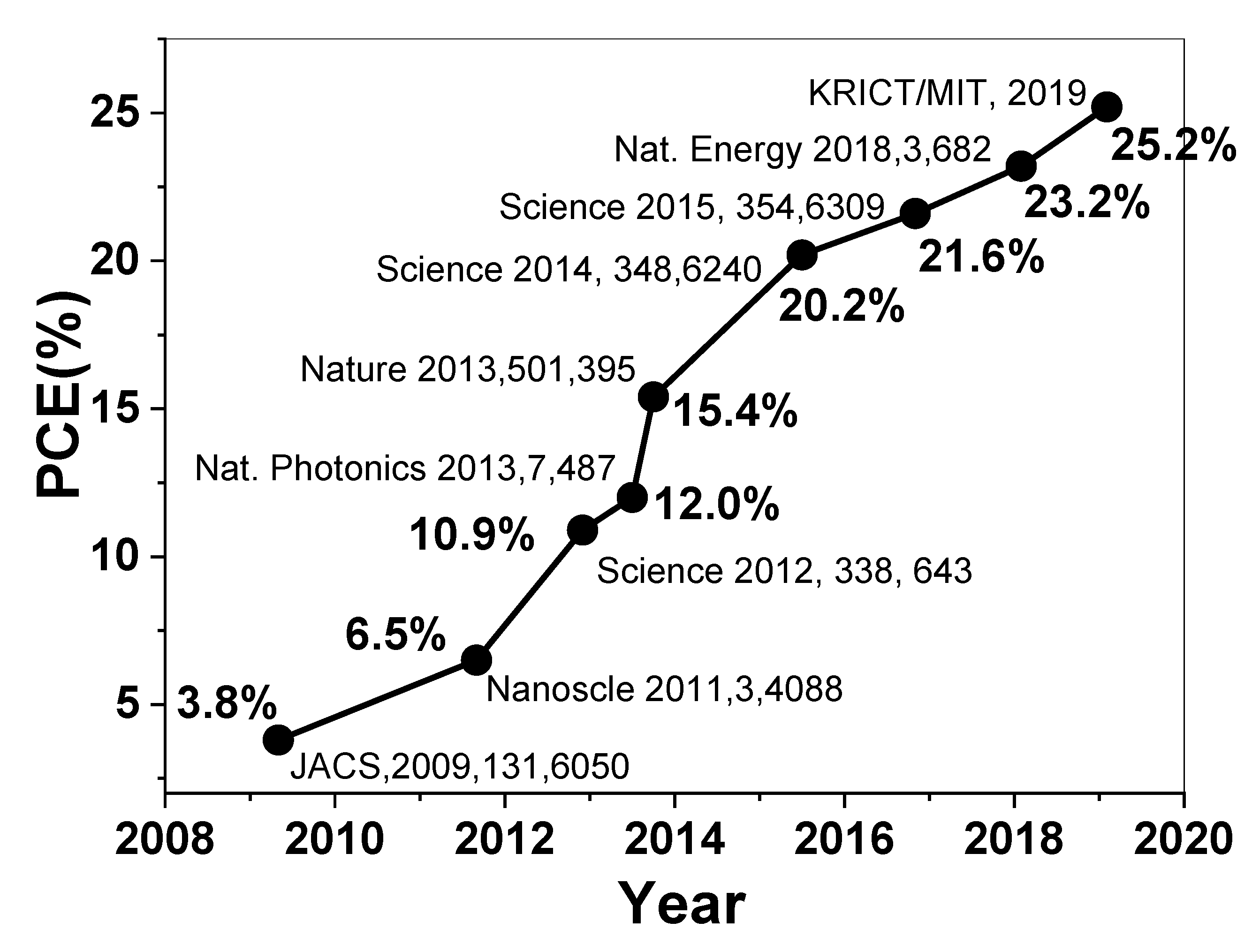
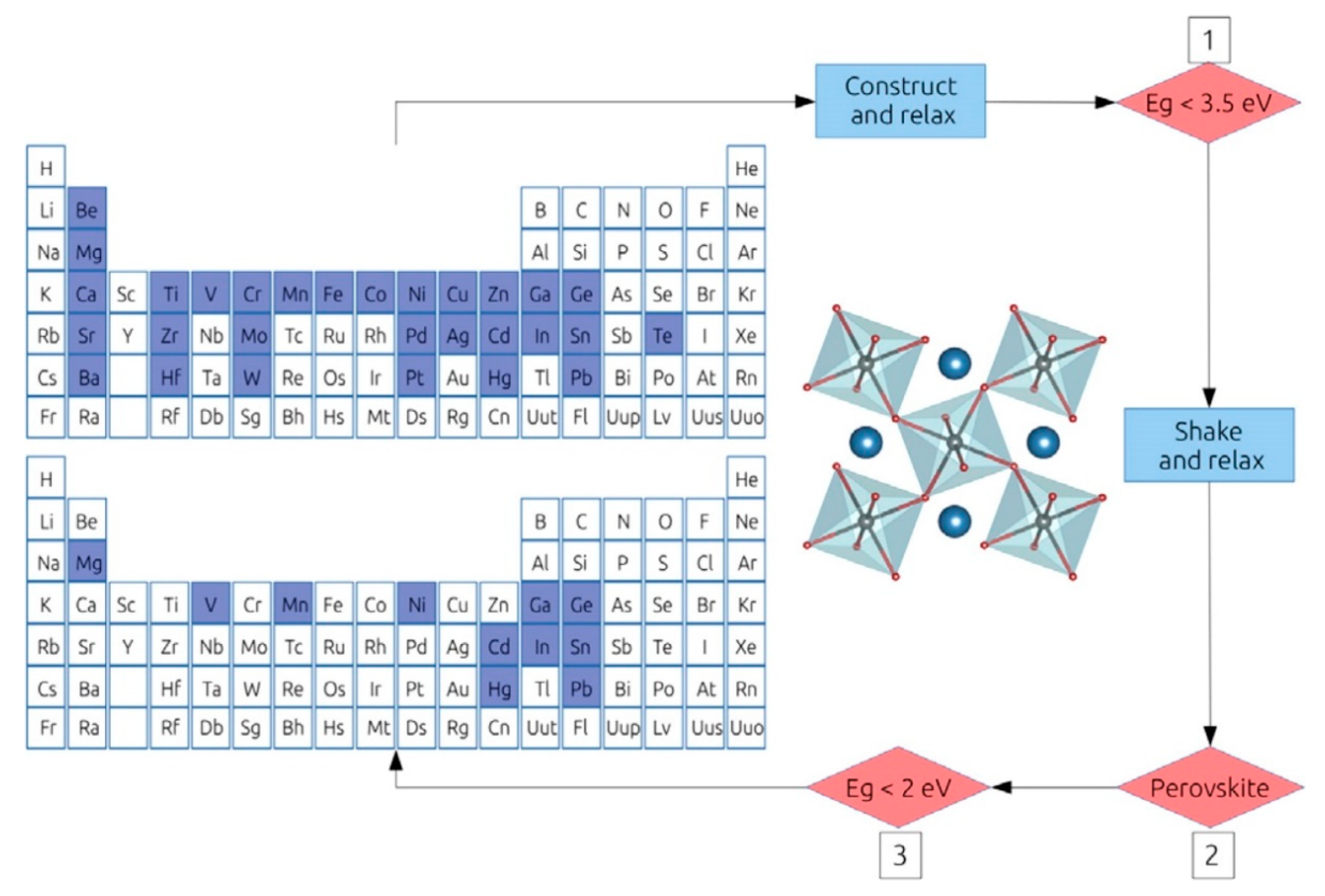
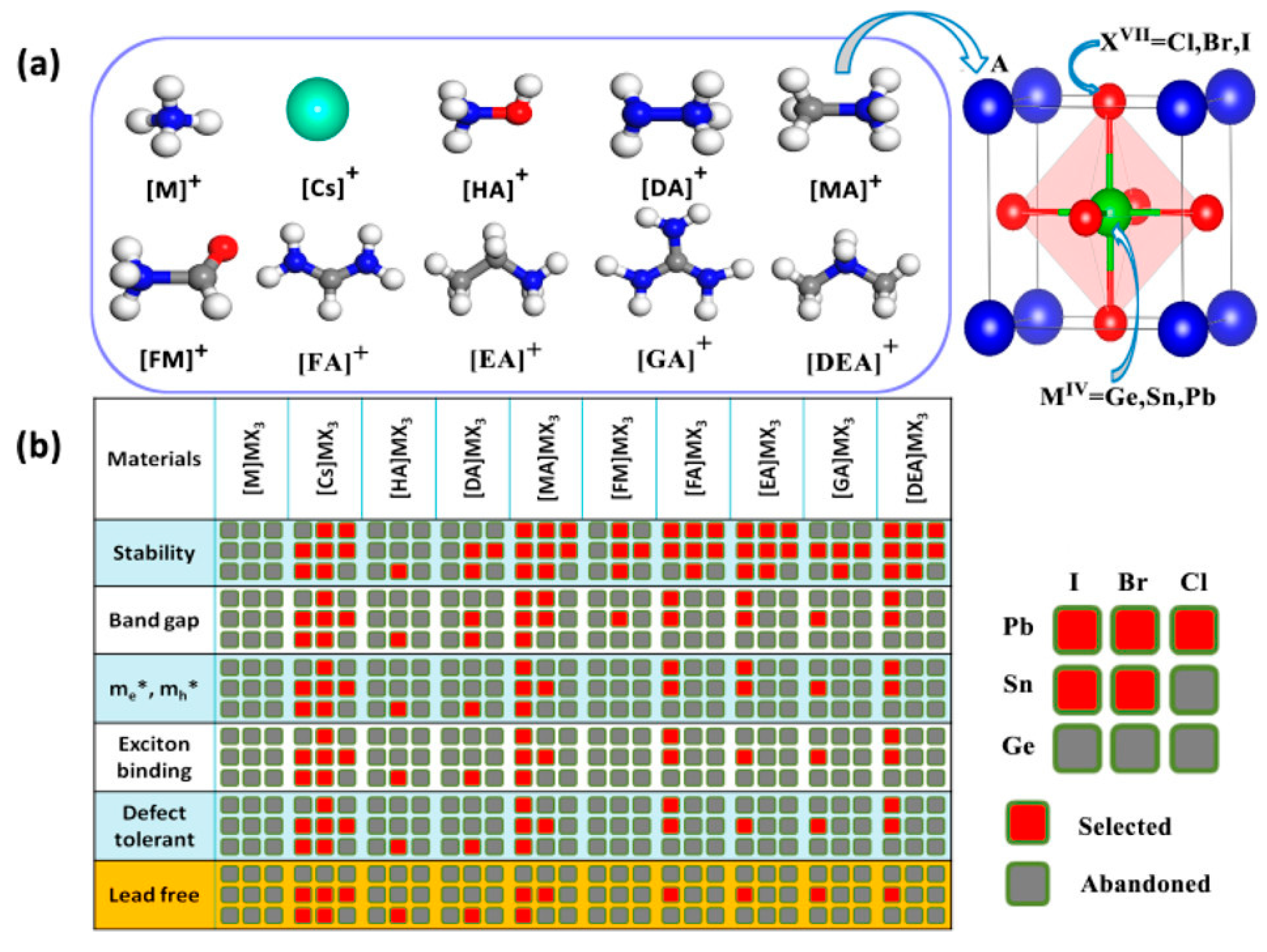

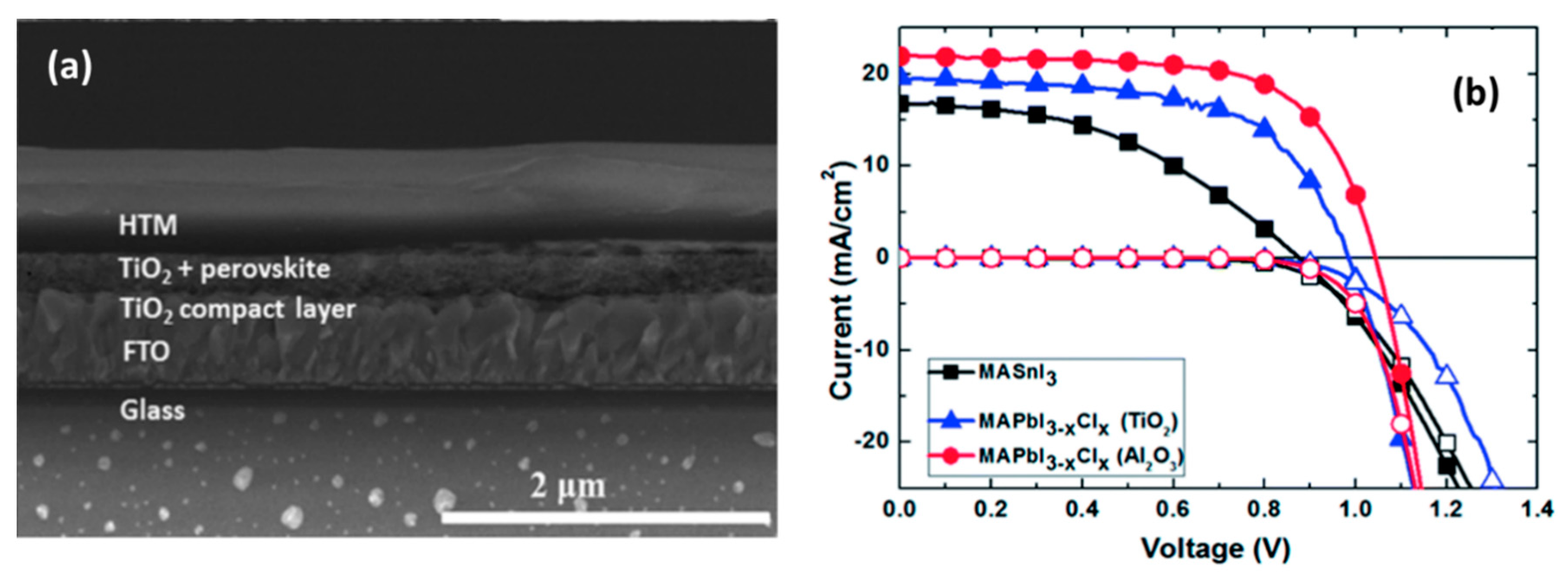







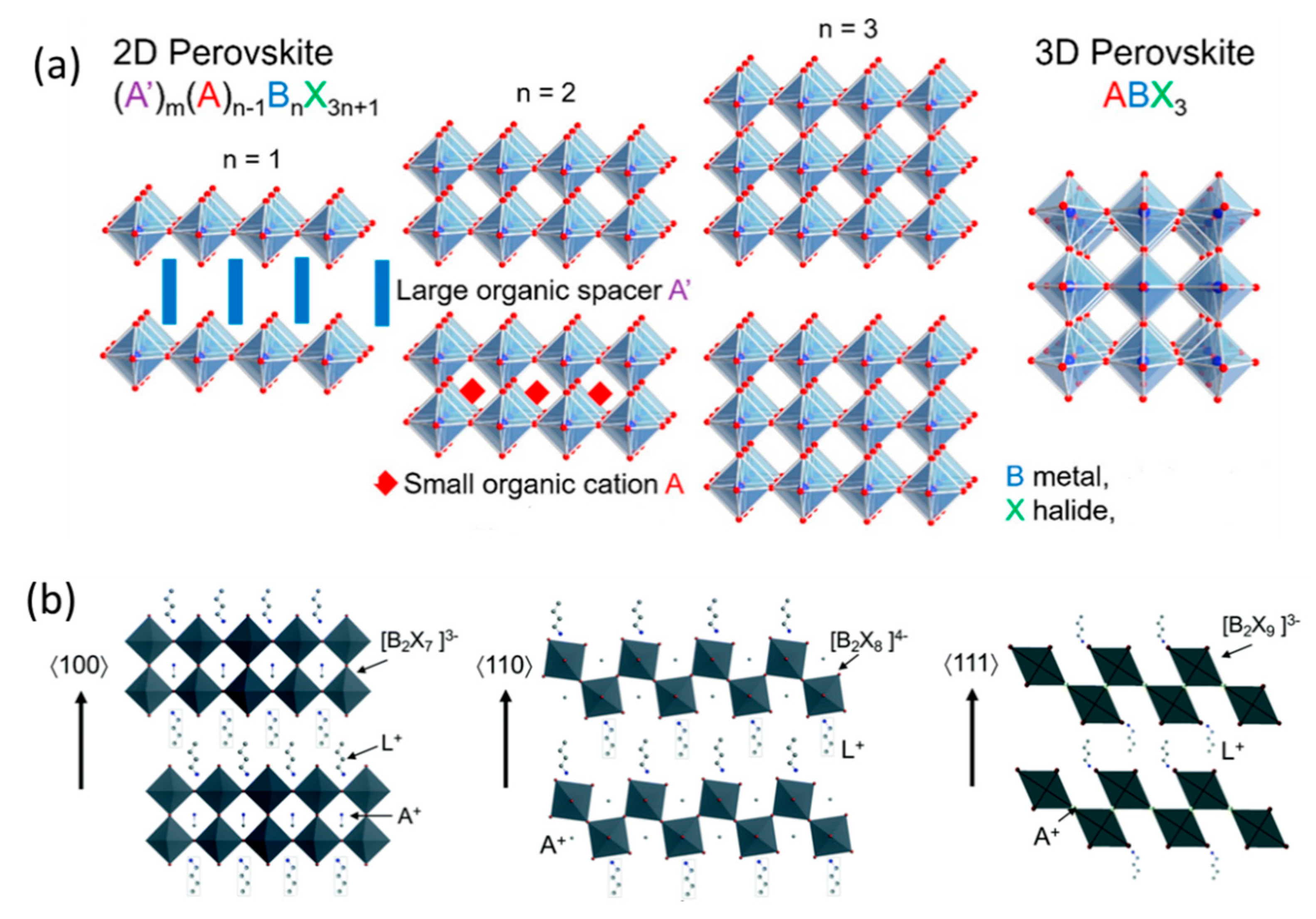
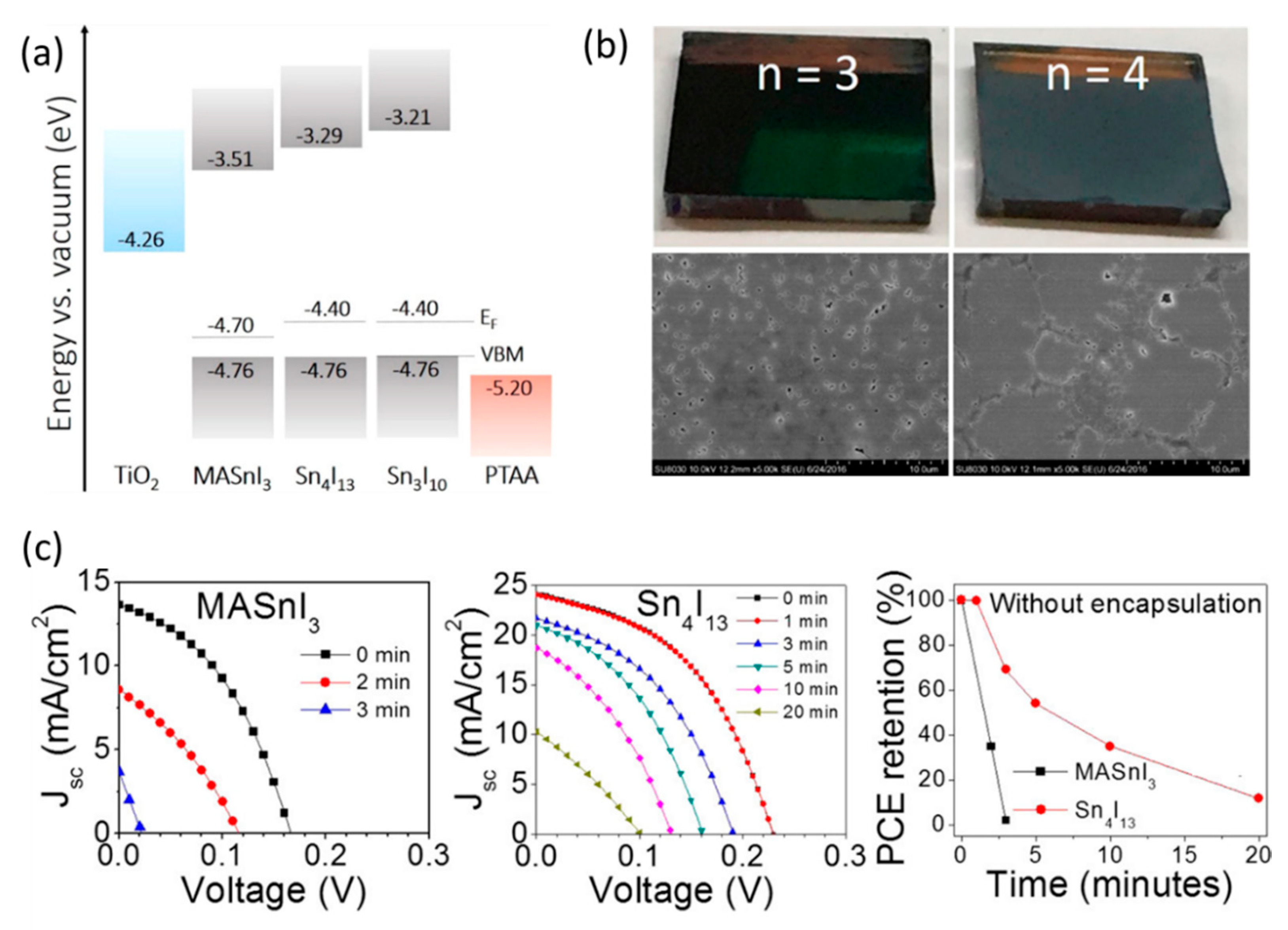
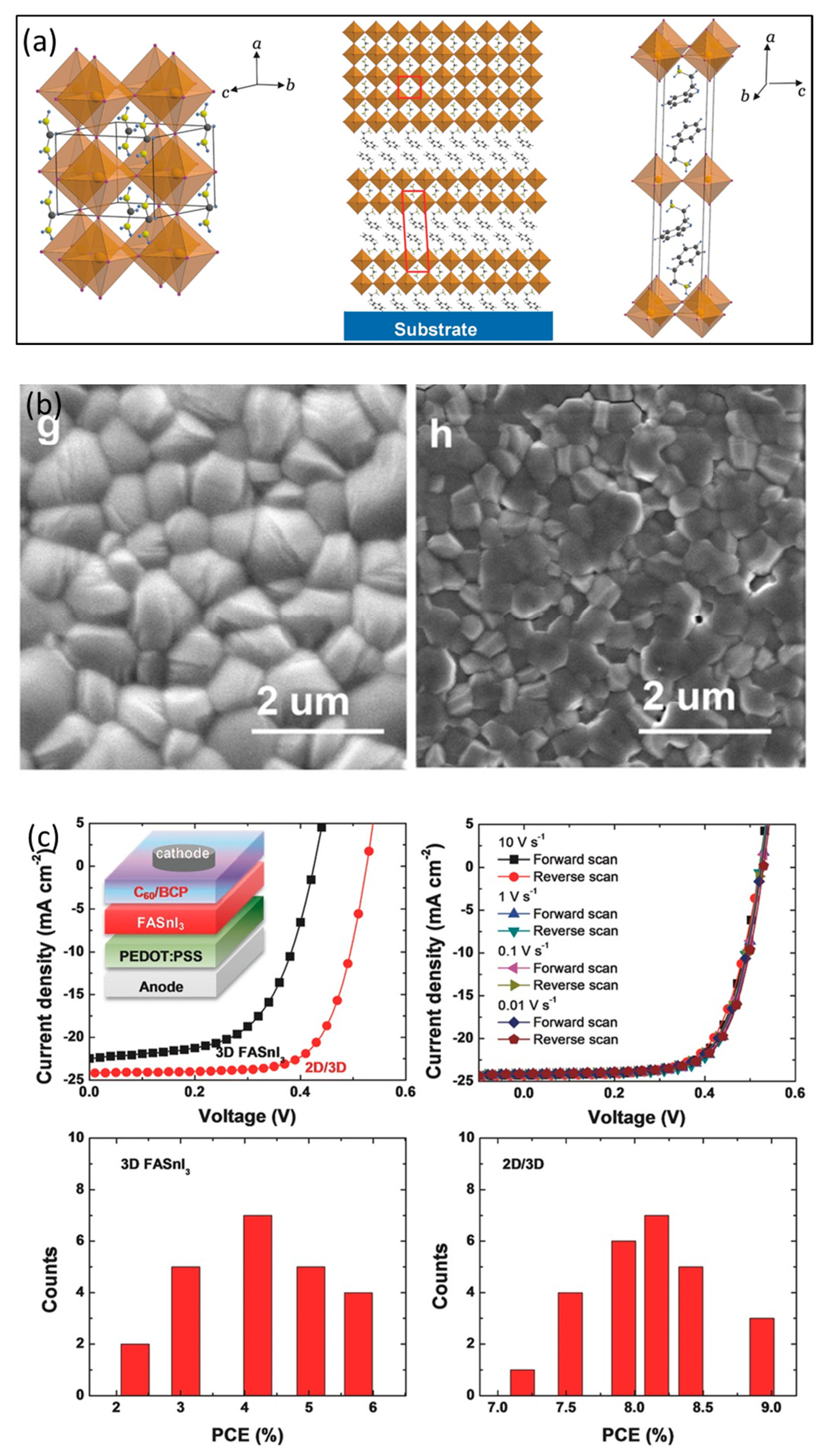
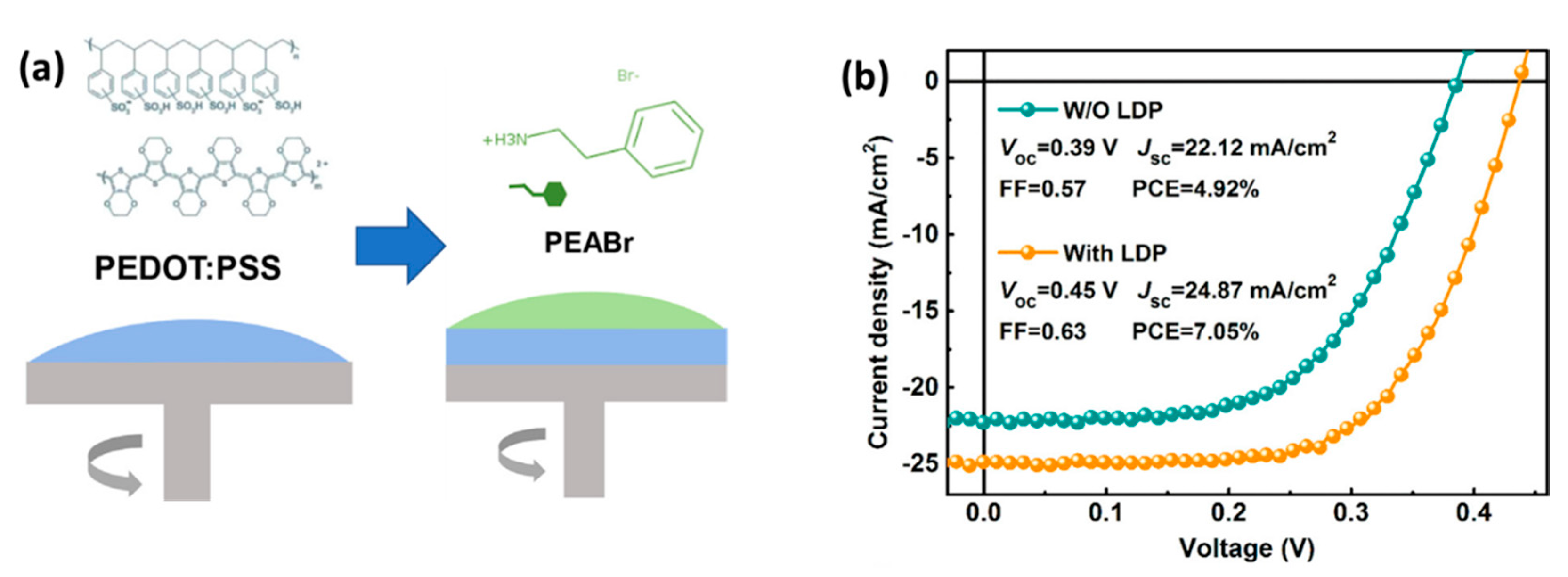

| Device Structure | PCE (%) | Jsc (mA/cm2) | Voc (V) | FF (%) | Ref. |
|---|---|---|---|---|---|
| FTO/c-TiO2/mp-TiO2/MASnI3/Spiro-OMeTAD/Au | 6.4 | 16.8 | 0.88 | 42 | [50] |
| FTO/c-TiO2/mp-TiO2/MASnI3/Spiro-OMeTAD/Au | 5.2 | 16.3 | 0.68 | 48 | [48] |
| FTO/c-TiO2/mp-TiO2/MASnI3/PTAA/Au | 3.9 | 10.9 | 0.38 | 52 | [58] |
| FTO/c-TiO2/mp-TiO2/MASnI3:SnF2/Au | 3.2 | 21.4 | 0.32 | 46 | [57] |
| ITO/PDEOT:PSS/MASnI3/C60/BCP/Au | 2.1 | 11.8 | 0.45 | 40 | [59] |
| FTO/c-TiO2/mp-TiO2/MASnI3/PTAA/Au | 1.9 | 17.4 | 0.27 | 39 | [60] |
| ITO/PDEOT:PSS/Poly-TPD/MASnI3/C60/BCP/Au | 1.7 | 12.1 | 0.38 | 37 | [58] |
| FTO/c-TiO2/mp-TiO2/MASnI3/PTAA/Au | 3.8 | 19.9 | 0.38 | 51 | [58] |
| ITO/PEDOT:PSS/MASnI3:SnF2/C60/BCP/Ag | 4.2 | 21.4 | 0.43 | 63 | [61] |
| FTO/c-TiO2/mp-TiO2/en MASnI3:SnF2/PTAA/Au | 6.6 | 24.3 | 0.43 | 63 | [62] |
| ITO/PEDOT:PSS/NiOx/MASnI3/PC61BM/Al | 3.2 | 17.8 | 0.60 | 30 | [63] |
| FTO/c-TiO2/mp-TiO2/MASnI3/Spiro-OMeTAD/Au | 5.4 | 15.2 | 0.72 | 50 | [43] |
| FTO/c-TiO2/mp-TiO2/MASnI3:SnF2/Spiro-OMeTAD/Au | 1.9 | 26.1 | 0.25 | 30 | [64] |
| FTO/c-TiO2/mp-TiO2/MASnI3:SnF2/Spiro-OMeTAD/Au | 2.3 | 26.0 | 0.23 | 39 | [65] |
| Device Structure. | PCE (%) | Jsc (mA/cm2) | Voc (V) | FF (%) | Ref. |
|---|---|---|---|---|---|
| FTO/c-TiO2/mp-TiO2/FASnI3:SnF2/Spiro-OMeTAD/Au | 2.1 | 24.5 | 0.24 | 36 | [72] |
| ITO/PEDOT:PSS/FASnI3:SnF2/C60/BCP/Ag | 6.6 | 21.3 | 0.48 | 64 | [79] |
| FTO/c-TiO2/mp-TiO2/FASnI3:SnF2/Spiro-OMeTAD/Au | 4.8 | 23.7 | 0.32 | 63 | [71] |
| ITO/PEDOT:PSS/FASnI3:SnF2/C60/BCP/Ag | 6.2 | 22.1 | 0.47 | 61 | [73] |
| FTO/c-TiO2/mp-TiO2/ZnS/FASnI3:SnF2/PTAA/Au | 5.3 | 23.1 | 0.38 | 60 | [80] |
| FTO/c-TiO2/mp-TiO2/en FASnI3/PTAA/Au | 7.1 | 22.5 | 0.48 | 66 | [63] |
| ITO/PEDOT:PSS/FASnI3:SnF2/C60/BCP/Ag | 3.9 | 18.4 | 0.31 | 67 | [81] |
| ITO/PEDOT:PSS/FASnI3:SnF2/C60/BCP/Ag | 4.0 | 17.6 | 0.36 | 62 | [82] |
| ITO/PDEOT:PSS/FASnI3:SnF2/PCBM/BCP/Ag | 5.1 | 22.1 | 0.37 | 63 | [83] |
| ITO/PDEOT:PSS/FASnI3:SnF2:N2H5Cl/PCBM/BCP/Ag | 5.4 | 17.6 | 0.46 | 67 | [84] |
| ITO/PDEOT:PSS/FASnI3/C60/BCP/Ag | 4.0 | 17.8 | 0.33 | 68 | [85] |
| Device Structure | PCE (%) | Jsc (mA/cm2) | Voc (V) | FF (%) | Ref. |
|---|---|---|---|---|---|
| FTO/c-TiO2/mp-TiO2/CsSnI3:SnI2/PTAA/Au | 4.8 | 25.7 | 0.38 | 49 | [97] |
| ITO/CuI/CsSnI3:SnI2/ICBA/BCP/Al | 2.8 | 12.3 | 0.43 | 39 | [98] |
| ITO/NiOx/CsSnI3/PCBM/Al | 3.3 | 10.2 | 0.52 | 62 | [99] |
| ITO/CsSnI3:SnCl2/PC61BM/BCP/Al | 3.6 | 9.9 | 0.50 | 68 | [100] |
| ITO/c-TiO2/mp-TiO2/CsSnI3:SnF2/PTAA/Au | 1.8 | 30.8 | 0.17 | 34 | [58] |
| ITO/c-TiO2/mp-TiO2/CsSnI3:SnF2/m-MTDATA/Au | 2.0 | 27.7 | 0.24 | 37 | [89] |
| FTO/c-TiO2/mp-TiO2/CsSnI3:SnF2/Spiro-OMeTAD/Au | 1.7 | 22.7 | 0.20 | 29 | [94] |
| ITO/CsSnI3/Au/Ti | 0.9 | 4.8 | 0.42 | 22 | [40] |
| FTO/c-TiO2/mp-TiO2/CsSnI3/Spiro-OMETAD/Au | 1.9 | 15.2 | 0.26 | 46 | [93] |
| Sn-Based Perovskites | |||
|---|---|---|---|
| MASnI3 | FASnI3 | CsSnI3 (B-γ) | |
| Space group | P4mm | Amm2 | pnma |
| Room temperature crystal system | tetragonal | orthorhombic | orthorhombic |
| Unit cells dimensions (Å) | a = 6.2302 (10) | a = 6.3286 (10) | a = 8.6885 (5) |
| b = 6.2302 (10) | b = 8.9554 (11) | b = 12.3775 (4) | |
| c = 6.2316 (11) | c = 8.9463 (11) | c = 8.6384 (6) | |
| Density (g/cm3) | 3.649 | 3.566 | 4.521 |
| Bandgap (eV) | ~1.25–1.3 | ~1.4 | 1.3 |
| Absorption coefficient (mm−1) | 12.128 | 11.579 | 16.482 |
| F (000) | 228 | 468 | 1056 |
| crystal dimensions (mm3) | 0.053 × 0.032 × 0.021 | 0.176 × 0.163 × 0.136 | / |
| Exciton binding energy (meV) | 29 | 31 | 18 |
| Electron mobility (cm/V/s) | 2320 | 103 | 536 |
| Hole mobility (cm/V/s) | 322 | / | 585 |
| A-Cations | PCE (%) | Jsc (mA/cm2) | Voc (V) | FF (%) | Ref. |
|---|---|---|---|---|---|
| FA+ + 20% PEA+ | 6.0 | 14.4 | 0.59 | 69 | [101] |
| FA+ + 8% PEA+ | 9.0 | 24.1 | 0.53 | 71 | [102] |
| FA+ + 100% Bn+ | 2.4 | 10.6 | 0.40 | 55 | [106] |
| FASnI3/PEABr | 7.1 | 24.9 | 0.45 | 63 | [115] |
| PEABr/FASnI3 | 7.9 | 22.6 | 0.54 | 64 | [76] |
| FA+ + 15% PEA+ | 9.4 | 22.0 | 0.61 | 70 | [68] |
| (PEA, FA)+ | 7.0 | 20.0 | 0.47 | 74 | [81] |
| FA+ + 15% BA+ | 5.5 | 18.0 | 0.44 | 69 | [118] |
| FA+ + 1% EDAI+ | 8.9 | 21.3 | 0.58 | 72 | [118] |
| FA+ + 50% 5AVAI+ | 7.0 | 18.9 | 0.59 | 62 | [84] |
© 2019 by the authors. Licensee MDPI, Basel, Switzerland. This article is an open access article distributed under the terms and conditions of the Creative Commons Attribution (CC BY) license (http://creativecommons.org/licenses/by/4.0/).
Share and Cite
Gai, C.; Wang, J.; Wang, Y.; Li, J. The Low-Dimensional Three-Dimensional Tin Halide Perovskite: Film Characterization and Device Performance. Energies 2020, 13, 2. https://doi.org/10.3390/en13010002
Gai C, Wang J, Wang Y, Li J. The Low-Dimensional Three-Dimensional Tin Halide Perovskite: Film Characterization and Device Performance. Energies. 2020; 13(1):2. https://doi.org/10.3390/en13010002
Chicago/Turabian StyleGai, Cuili, Jigang Wang, Yongsheng Wang, and Junming Li. 2020. "The Low-Dimensional Three-Dimensional Tin Halide Perovskite: Film Characterization and Device Performance" Energies 13, no. 1: 2. https://doi.org/10.3390/en13010002
APA StyleGai, C., Wang, J., Wang, Y., & Li, J. (2020). The Low-Dimensional Three-Dimensional Tin Halide Perovskite: Film Characterization and Device Performance. Energies, 13(1), 2. https://doi.org/10.3390/en13010002






